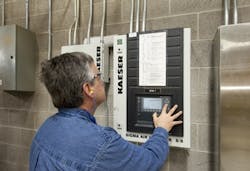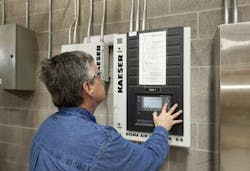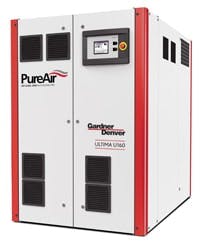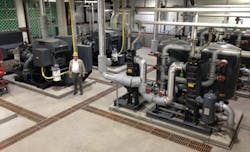Upgrade Compressed Air Systems
The state of compressed air systems at many plants frustrates consultants and vendors. “Compressed air is one of the most inefficient utilities within any industrial plant, and often the most ignored, until trouble starts,” notes Ron Marshall, chief auditor, Marshall Compressed Air Consulting, Winnipeg, Man. Yet, most sites have ample opportunities to achieve better energy efficiency, specialists say.
The crucial first step for improving energy efficiency is to measure the key performance parameters of a compressed air system and its associated equipment with an air audit (Figure 1). “Plant personnel are often surprised at how bad their system really is and very happy that something can be done about it,” Marshall stresses.
Figure 1. A check of a compressed air system often reveals subpar performance. Source: Marshall Compressed Air Consulting.
Following the audit, operating companies frequently require guidance as to the best technology for their particular process. This usually involves answering questions such as whether to use oil-lubricated or oil-free compressors, how best to recover and re-use heat generated during compression, and whether a variable speed drive (VSD) is appropriate?
For example, pharmaceutical and other plants demanding very high air quality generally opt for oil-free systems. However, oil-free compressors are much costlier to purchase and maintain, cautions Marshall. “The oil-free compressors themselves are usually slightly less efficient at full load than oil-lubricated, but switching allows the heat of compression to be used in the desiccant drying of the air, which saves energy, where applicable,” he explains.
[callToAction ]
Because most of the energy input to an air compressor of any type comes out as heat, there’s a big drive to recover it and so improve system efficiency. “A common heat recovery strategy is to use the heat of compression for building heat but its best use is for a continuous process such as boiler makeup or producing hot water,” counsels Marshall. The compressor heat can help dry the air more efficiently, too, where very low dew points are required.
VSDs usually make sense because a compressor in the unloaded state can waste a lot of energy. “Unloaded screw compressors can consume between 20–40% of their full-load power while producing zero air. VSD technology helps reduce or eliminate unloaded run time while better stabilizing the system pressure. Use of VSD technology, where appropriate, can both improve the efficiency of the production of compressed air and help save more if leakage and compressed air waste is reduced at the same time,” he notes.
Modern onboard control systems also can contribute to better efficiency. However, Marshall feels more work is needed on standardizing the communication protocols for air compressors: “At this point, unlike the HVAC [heating, ventilation, air-conditioning] industry, it is rare to find any compressor from one manufacturer with the ability to easily integrate with another manufacturer’s communication system.”
Chemical makers are showing greater awareness of the total lifecycle costs of their compressed air systems, he says, particularly as a result of compressor and dryer verification initiatives and rating sheets offered by organizations such the Compressed Air & Gas Institute (CAGI).
More Efficient Options
The need to improve energy efficiency is one of the main drivers for the chemical industry’s move to more-efficient air compressor technology, emphasizes Richard Hinkle, global product director for Gardner Denver, Quincy, Ill. “There’s no question about that. Being efficient and using utility compressed air properly saves dollars and people do know that now.”
Figure 2. New oil-free compressor design eliminates friction-causing components. Source: Gardner Denver.
“Generally, there is an increased emphasis on reducing carbon footprint and, since the upfront cost of the equipment is only about 10% of the total cost of air system operation over a 5–10 year period, the major focus is on reducing the energy cost — and rightly so. In many cases, air audits reveal to customers the ability to save $100,000 or more annually in energy costs compared to their existing set-up,” adds Gardner Denver’s Bryan Fasano, director, aftermarket, industrials group.
When considering an air compressor system, Hinkle suggests answering three main questions: How do you select the most efficient compressor for a given system? What downstream equipment is involved in that system? How do you optimize the whole system over the lifetime of the compressor and its associated equipment?
“We spend time making absolutely sure that our people are applying the most appropriate technology in the best possible way. It’s the knowledge of how to do this that is very lacking in the industry as a whole,” he notes.
A recent project with ACU Pharma und Chemie, Apolda, Germany, exemplifies the value of proper application of technology. ACU, which specializes in the precision milling and micronizing of high-quality powders and compound mixtures, relies on special air jet mills that require very pure and dry compressed air for optimal micronization. The company needed to expand its compressed air system and decided to fundamentally restructure it with the aim of generating efficient, flexible, oil-free and dry compressed air with a high degree of production reliability.
ACU also required compressed air with the same exacting quality requirements for other services, including bearing seal purging, pneumatic valve operation and for laboratory equipment used to measure particle size.
The company had been using three oil-lubricated screw compressors with complex centralized and decentralized treatment, including an activated carbon absorber for separating the oil vapor.
Following thorough examination, ACU selected four oil-free DH CompAir compressors by Gardner Denver, three units with 75-kW motor power and one 37-kW unit, and upgraded compressed air treatment. The compressor blocks are water-cooled and allow compressor temperatures to reach a maximum of only 60°C, making the compression process practically isothermal. In addition, a refrigerant dryer — connected upstream of the desiccant dryer that treats pre-dried compressed air — prepares compressed air with a dew point of -40°C. This avoids the need for second desiccant dryer and also reduces the wear and energy consumption of the installed desiccant dryer.
One trend Gardner Denver is seeing is a big growth in interest in oil-free compressor technologies such as high-speed centrifugal compressors that won’t carry lubricant downstream into the system. “Use of oil-free is expanding into specialty chemicals and into mainstream chemicals, especially where the application benefits from oil-free air such as instrument air,” says Fasano.
To further improve efficiency, the company has developed designs that eliminate components that cause friction and energy loss (Figure 2), he adds. Other product redesigns include upgraded rotor profiles. The company also is looking at whole package issues such as decreasing pressure drops in piping runs and improving overall system control and monitoring. In addition, it aims for a greater role in monitoring and maintaining equipment in the field. “If we are monitoring, we can catch changes in energy efficiency very quickly and have [them] visible to our service people, who are trained to identify and fix these sorts of system changes,” he notes.
Figure 3. Compressor package saves over $31,000/y and paid for itself in under 10 months. Source: Atlas Copco.
Specific Goals
The chemical industry is showing greater interest in oil-free compressors, agrees Deepak Vetal, product marketing manager at Atlas Copco Compressors, Rock Hill, S.C. He cites three main reasons: good quality air allows doing away with some expensive filtration systems; a general move away from heatless dryers; and the availability of modern controllers that can optimize the entire compressed air system in a plant.
“The need to optimize energy consumption is very important for chemical companies and I have seen specific goals being set for compressed air reduction, for example by 10%, by a number of them,” Vetal says.
“Users can save 20–25% on energy consumption when switching to oil-free compressors. With heatless dryers, you normally have a 15–20% purge loss that can be saved by using no-loss heat of compression dryers,” he stresses.
A move toward more equipment testing to detect pressure changes/leaks, and the ability to operate air compression systems at lower pressure also are boosting energy efficiency.
“The focus here is on the total compressed air installation, including efficiency in generation on the supply side, efficiency in distribution and then efficiency in use on the demand side. We are improving on compression technology that increases efficiency, prevents pressure drops and improves motor efficiency. The goal is to save on total package power,” he explains.
For instance, the recently introduced ZR and ZT oil-free air compressors come as part of a full package that includes integrated dryers for ease of installation, VSDs and Smartlink remote monitoring boxes that can spot abnormal activity and send messages to users about the need to schedule maintenance.
To illustrate the savings possible, Patel cites a recent project carried out with the largest paperboard and packaging firm in North America. That company’s goal was to reduce plant energy costs and discontinue the use of rental compressors. It installed an energy-efficient 2xZH560 oil-free compressor with XD dryer (Figure 3) and replaced the older, existing heatless dryers with a BD dryer. “Payback initially took just over 11 months, but we took another 1.5 months off that when additional savings were found,” he notes.




